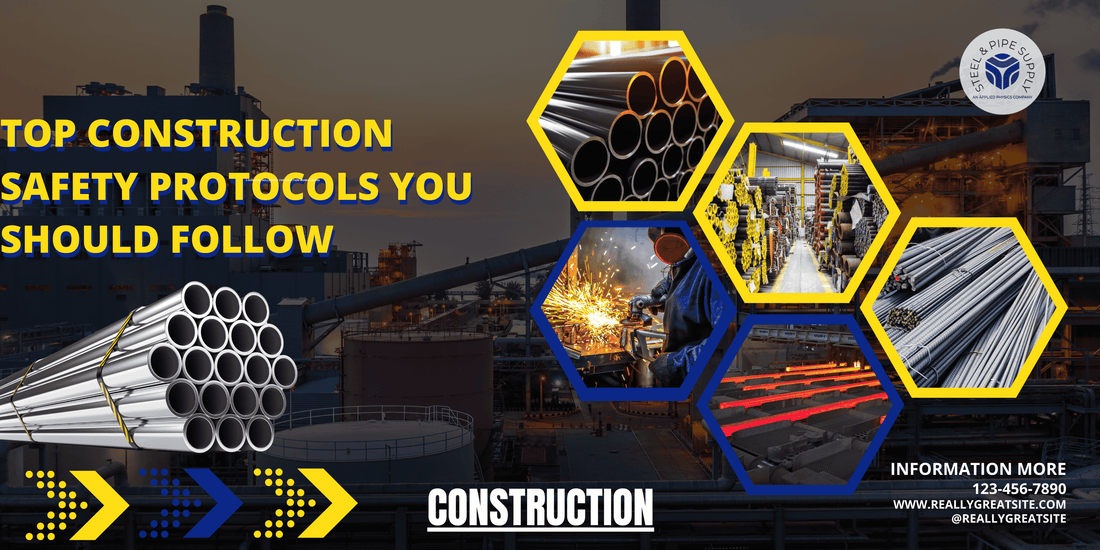
Top Construction Safety Protocols You Should Follow
Share
Introduction
Construction safety protocols are crucial for ensuring the well-being of workers and preventing accidents and injuries on construction sites. These protocols are designed to identify and mitigate potential hazards, promote safe work practices, and comply with regulatory standards. By implementing and adhering to these protocols, construction companies can protect their workers, reduce the risk of costly accidents, and maintain a positive reputation within the industry.
Additionally, prioritizing safety protocols can lead to increased productivity, as workers feel more secure and confident in their working environment. Furthermore, construction safety protocols are essential for legal compliance. Regulatory bodies such as the Occupational Safety and Health Administration (OSHA) in the United States have stringent requirements for construction safety, and non-compliance can result in severe penalties and legal consequences.
Therefore, it is in the best interest of construction companies to prioritize safety protocols to avoid legal liabilities and maintain a safe working environment for their employees.
Key Takeaways
- Construction safety protocols are crucial for preventing accidents and injuries on construction sites.
- Implementing construction safety protocols can help save lives, reduce injuries, and minimize property damage.
- Key construction safety protocols to implement include fall protection, hazard communication, and proper equipment inspection and maintenance.
- Personal protective equipment (PPE) requirements include hard hats, safety glasses, gloves, and high-visibility clothing.
- Best practices for hazard communication include labeling hazardous materials, providing safety data sheets, and training workers on the potential hazards.
Key Construction Safety Protocols to Implement
1. Personal Protective Equipment (PPE) Requirements
Personal Protective Equipment (PPE) is a fundamental aspect of construction safety protocols. PPE includes items such as hard hats, safety glasses, gloves, high-visibility clothing, and steel-toed boots. These items are designed to protect workers from various hazards present on construction sites, including falling objects, electrical hazards, and exposure to harmful substances. Implementing strict PPE requirements and ensuring that all workers comply with them is essential for preventing injuries and maintaining a safe work environment.
2. Best Practices for Hazard Communication
Effective hazard communication is vital for ensuring that workers are aware of potential dangers on the construction site. This includes properly labeling hazardous materials, providing safety data sheets (SDS) for chemicals, and conducting thorough training on hazard recognition and communication. By promoting clear and comprehensive communication about potential hazards, construction companies can empower their workers to make informed decisions and take necessary precautions to avoid accidents.
Personal Protective Equipment (PPE) Requirements
Personal Protective Equipment (PPE) is a critical component of construction safety protocols, as it serves as the last line of defense against workplace hazards. PPE requirements may vary depending on the specific tasks being performed and the potential risks present at the construction site. For example, workers involved in welding or cutting activities may need specialized eye protection and flame-resistant clothing, while those working at heights may require fall protection equipment such as harnesses and lanyards.
Employers need to provide appropriate PPE to their workers free of charge and ensure that it fits properly and is in good condition. Additionally, workers must be trained on the proper use, maintenance, and limitations of their PPE. Regular inspections of PPE should be conducted to identify any signs of wear or damage and any defective equipment should be replaced immediately.
By prioritizing PPE requirements, construction companies can significantly reduce the risk of injuries and create a safer working environment for their employees.
Best Practices for Hazard Communication
| Best Practices for Hazard Communication | Metrics |
|---|---|
| Employee Training | Number of training sessions conducted |
| Material Safety Data Sheets (MSDS) | Percentage of updated MSDS available |
| Labeling of Hazardous Chemicals | The compliance rate with labeling requirements |
| Hazardous Chemical Inventory | Accuracy of inventory records |
Hazard communication is a critical aspect of construction safety protocols that involves effectively conveying information about workplace hazards to employees. This includes identifying and labeling hazardous materials, providing safety data sheets (SDS) for chemicals, and ensuring that workers receive comprehensive training on hazard recognition and communication. Clear and consistent communication about potential hazards enables workers to understand the risks associated with their tasks and take appropriate precautions to protect themselves.
Employers should establish a robust hazard communication program that outlines procedures for identifying, evaluating, and controlling workplace hazards. This program should also include guidelines for proper labeling of hazardous materials, as well as protocols for accessing safety data sheets and other relevant information. Regular training sessions should be conducted to educate workers about the specific hazards they may encounter on the job site and how to respond in case of an emergency.
By prioritizing effective hazard communication, construction companies can empower their workers to make informed decisions and contribute to a safer work environment.
Steps for Proper Equipment Inspection and Maintenance
Proper equipment inspection and maintenance are essential components of construction safety protocols that help prevent accidents and ensure the longevity of tools and machinery. Regular inspections should be conducted to identify any signs of wear, damage, or malfunction in construction equipment, power tools, scaffolding, and other machinery used on the job site. Any defective equipment should be immediately taken out of service and repaired or replaced as necessary.
In addition to regular inspections, scheduled maintenance procedures should be established to keep equipment in optimal working condition. This may include lubrication, cleaning, calibration, and other preventive maintenance tasks recommended by equipment manufacturers. Proper storage of equipment when not in use is also crucial to prevent deterioration or damage.
By implementing thorough equipment inspection and maintenance protocols, construction companies can minimize the risk of equipment-related accidents and ensure that workers have access to safe and reliable tools for their tasks.
Emergency Response and Evacuation Procedures
Emergency response and evacuation procedures are vital components of construction safety protocols that prepare workers to respond effectively in case of unforeseen incidents such as fires, chemical spills, or structural failures. Employers should develop comprehensive emergency action plans that outline specific procedures for reporting emergencies, evacuating the job site, and providing first aid or medical assistance when necessary. These plans should be communicated to all workers and regularly reviewed to ensure their effectiveness.
In addition to having well-defined emergency response procedures, construction companies should provide adequate training to workers on how to respond to different types of emergencies. This may include conducting drills to simulate emergency scenarios and familiarize workers with evacuation routes, assembly points, and the proper use of fire extinguishers or other emergency equipment. By prioritizing emergency response and evacuation procedures, construction companies can minimize the potential impact of unforeseen events and ensure the safety of their workforce.
Training and Education for Construction Safety
Training and education are fundamental aspects of construction safety protocols that empower workers with the knowledge and skills necessary to identify hazards, follow safe work practices, and respond effectively in case of emergencies. Employers should provide comprehensive safety training to all workers before they begin their tasks on the job site, covering topics such as hazard recognition, PPE usage, equipment operation, emergency procedures, and regulatory compliance. Furthermore, ongoing education and training programs should be implemented to keep workers informed about new safety regulations, best practices, and emerging technologies in the construction industry.
This may include regular toolbox talks, safety meetings, or specialized training sessions tailored to specific job roles or tasks. By investing in training and education for construction safety, employers can cultivate a culture of safety awareness among their workforce and reduce the likelihood of workplace accidents or injuries.
Conclusion
Construction safety protocols play a pivotal role in safeguarding the well-being of workers, preventing accidents, and ensuring legal compliance within the construction industry. By prioritizing key protocols such as personal protective equipment requirements, hazard communication best practices, equipment inspection, and maintenance procedures, emergency response plans, and comprehensive training programs, construction companies can create a safer working environment for their employees while also enhancing productivity and reputation within the industry. Adhering to these protocols not only protects workers from harm but also contributes to the overall success and sustainability of construction projects.

